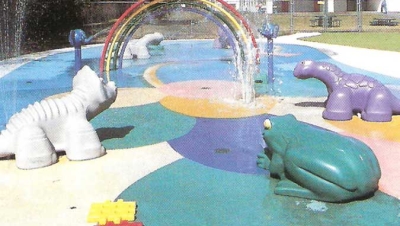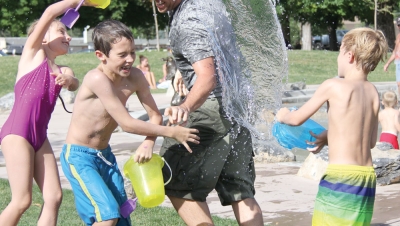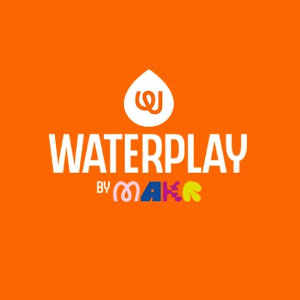Make your own splash!
Geysers, fountains, gizmos, and gadgets—Children and adults alike delight in the latest concept in community-based programming . . . the water playground!
“The inclusion of water playgrounds into municipal parks is on the rise. These interactive areas can be located adjacent to other recreation venues or in stand-alone parks or urban areas,” says Melinda Kempfer from Water Technology, Inc., an aquatic planning, design, and engineering firm headquartered in Wisconsin.
Imagine playing the day away in the hot sun while water surrounds you in a playful, innovative and safe environment. Children of all ages and their families are able to play together with interactive toys that shoot and spray water. Even the smallest of children can participate by turning valves, pulling levers and controlling the direction and flow of water. Safe for children of all ages and swimming abilities, these new colorful aquatic playgrounds have no standing water and do not require children to know how to swim. While playing in this imagination-provoking environment, children can become acclimated to water play and be entertained for hours on end. A specially designed safety surface helps keep the children safe while they explore the many gadgets that each water playground has to offer.
Families love to play together on these new aquatic venues that are safe, accessible to all and can challenge even the most creative child. Don’t be surprised to see the big kids and mom and dad busy at play too! In fact, these aquatic environments include everyone from infants to seniors.
Spraygrounds…the new Water Playgrounds
The sprayground is most often referred to as a spray park, splash pad, zero-depth aquatic play area, aquatic playground and wet deck, as well as a number of other terms. A wide range of shapes and sizes and the endless selection of features make these the hottest new aquatic novelty.
They are designed to be safe and unique play areas where water is sprayed from structures or ground sprays and then drained away before it can accumulate. Planning a spray park usually involves searching through an endless supply of catalogs, picking water toys that look like fun, and then placing them in a space that resembles the perfect play environment--one that stimulates the physical, psychological and social needs of children.
Water playgrounds have been very successful throughout the country in the park and recreation setting. Day camps have also found the water playground a cost-effective way to provide an aquatic experience to large numbers of campers. In addition to cost savings on capital budgets, these water playgrounds pose less risk than pools, especially with young children and inexperienced swimmers.
The key to a successful facility is to maintain a budget that allows operators to regularly update programming, aesthetics, and equipment. Operators also need to update their ideas about the kinds of amenities and services they offer and what they’re worth to patrons.
While some kids feel uncomfortable in an enormous pool of water, hardly anyone fears an animated spray park. It’s a comfortable and casual environment in which kids can build their confidence about being in water without the fears associated with swimming. Spray parks can provide the perfect transition to learning to swim.
“The basic steps to swimming (floats and glides) are much easier to do when you are relaxed. In spray parks, kids will stand and stare right up at water toys, drenching the big smile plastered across their face. This self-confidence can make learning to swim a whole lot easier,” says Kevin Weatherston from Waterplay Manufacturing Inc.
Something for everyone
Many communities have found that adding extra amenities and services to broaden the appeal of a facility is a great way to keep attendance high.
Today’s pool-goers demand the type of multipurpose facility that can cater to all aquatic tastes. Renovating a pool with zero-depth, water-play equipment, and a lap pool can be an answer to this.
Multipurpose amenities can range from shallow water and lazy rivers to aquatic play features, wave pools, movable floors and bulkheads, water slides, concessions, lounge and/or sandy beach areas, and a lap area for serious swimmers. Another plus of multipurpose pools is that different amenities can have vastly different uses, depending on the audience.
Amenities such as lounge chairs and shade structures can complete the picture of a perfectly relaxing day of aquatic fun.
“Families with small children like the way the park is laid out–separating the tots from the teens. Having a large zero beach area and lots of shade are key design features to making the facilities family friendly. Teens like the more extreme bowl slide. Bedford Splash is a great example of how much variety, excitement, and shade can be packed into a compact facility,” says Mark Hatchel from Kimley-Horn and Associates, who designed the new waterpark/leisure pool at Bedford Splash at Boys Ranch Outdoor Aquatic Center.
Entertainment value
Many in the industry agree that there are key features to keep bathers flocking to your waters. If there's a large budget and renovating or rebuilding are options, these features include: zero-depth or beach entry, which offers a very graduated entry for splashing the feet or easy entry into the water for the youngest children; zero-depth interactive splash play areas, also for younger children; and a variety of water-based play elements that can offer amusement or relaxation. These elements can range from different types of slides to vortexes and therapy couches. Other popular design features include lazy rivers for inner tubes and floating, as well as dry areas like shaded pavilions or grass for observing the action, hosting events or just socializing.
“The concept of Bedford Splash at Boys Ranch Family Aquatic Center was to create a compact, highly-themed municipal family aquatic center for aquatic recreation and play features for tots, families, and teens. Bright colors and tropical theming and signage were used to create a fun and attractive environment,” says Mr. Hatchel.
Many facilities also are moving to a shallow water emphasis to highlight the play features for all ages. Others minimize the lap lanes for competition swimming, or just provide fewer of them. But it's important to preserve the competitive aspect of the pool because there is still a segment of the population that wants that feature. It should not, however, be the only feature.
“Zero-depth and tube slides are synonymous with today’s aquatic centers–they aren’t new trends. People want to be entertained. Commercial waterparks are a big influence in the Municipal Family Aquatic Centers. FACs are making rides more exciting to keep up with the public’s entertainment needs. We are starting to see amenities like surf generators, speed slides, wave pools, water coasters, and multi-level play structures in public aquatic centers,” says Melinda Kempfer.
Zero-depth water recreation is gaining widespread acceptance by providing aquatic recreation that is ADA compliant, age-appropriate and without risk of drowning. Whether applied as a complement to aquatic facilities or as a stand-alone attraction, zero-depth interactive play features are a big hit with parents and pre-teens alike.
What’s Hot AND Cool with Aquatic Play–Zero-depth spray grounds are widely nominated as the first option when upgrading aquatic facilities. They can be developed as stand-alone parks in areas that formerly had no aquatic facilities or used to upgrade an existing pool or water park. These spraygrounds are relatively inexpensive to build and operate.
Running a close second with slides for that wow-factor are splash play features, shade features, and landscaping. Splash play features can provide recreation to the littlest users, making any aquatic space more family-friendly. Some splash play features can be derived from fountain designs doing double as eye-candy and play feature all in one.
Design elements
Children have incredible imaginations and will spend hours and hours creating their own play environments. Water play areas should be designed so that they are open and allow children to move freely and safely. It is important to encourage cooperative, whimsical play and provide a space that enhances lively social interaction.
Children who play in spray parks typically range in age from 2 to 12 years. Separate play areas should be created where the robust play of older children will not interfere with the passive play of younger children. Older children tend to enjoy cannons and squirt faces while younger children prefer the pass-through elements and the ground sprays.
An essential element of learning is the opportunity to affect the play environment. Children want to be able to spray their friends as well as be sprayed themselves. The simple act of filling a balloon full of water and throwing it at a friend can provide hours of fun for kids. If a simple balloon produces such joy, imagine the never-ending laughter an oversized water cannon can bring. Interactive toys benefit the social and physical development of all children.
Waterfalls have always been natural wonders of the world. Children love the idea of walking and looking through sheets of water. Being able to magically disappear behind a wall of water excites children of all ages. Mazes made from ground sprays offer magical fun as they allow children to disappear when they shoot up and then magically appear when the sprays stop.
While they may not look as attractive as the uprights when the water is turned off, ground sprays offer marvelous play value at a lower cost. Kids love altering the display of ground sprays by either sitting or standing on them. When planning a spray park, be extra generous with the number of ground sprays and select a variety of spray effects.
While the shape of one component may look different from another, the spray display could, in fact, be exactly the same. Be sure to check the spray effects of every water toy you select. Most manufacturers offer a variety of spray effects including dumping water, misty sprays, showers, geysers, jets, foam sprays, gushers, sprinklers, streams of water, or bubbles. When planning your park it’s best to mix it up and select an assortment of toys that include differing spray effects.
“One final trend that shouldn't be overlooked is theming. Themed environments within a park have become increasingly popular in municipal and commercial water parks. The ability to package some sort of experience and create an instant atmosphere transforms guests into another world as they navigate through the park. This concept creates excitement and a sense of arrival for the guest and can help to increase the length of stay,” states Ms. Kempfer.
Cost and Expansion
Spraygrounds are a cost-effective alternative to replacing old, outdated pools. Compared to pools, spraygrounds cost much less to install and run. One reason for this is the personnel needed to run a sprayground. Lifeguards are not required at most facilities, so personnel costs drop substantially from that of a standard flat-water pool. Another benefit is that because recirculating filtration systems are available, and in many cases required, you waste less water.
Once a venue installs a sprayground and the demand increases, you may want to add extra features. Leave room for expansion. Above-ground are easier to be rearranged. Features that are mounted in concrete will be there permanently.
Ms. Kempfer points out that all is not coming up roses though. “There are some misconceptions about water playgrounds. People think they are less work--when in reality they are not always less work. If the system has a recirculation system (not a potable water system) someone still has to keep an eye on sanitation levels, mechanical operations, etc. at least twice a day. There are also more moving parts and systems can be more complex with the controller that opens and closes valves in a sequence.”
Safety–The most important aspects of spraygrounds are their safety features. Because the attractions do not include standing water, the chance of drowning is virtually non-existent. Parents and kids alike can have a great experience as parents can relax more because their kids are in a much safer play environment.
A common misconception about spraygrounds is that they are virtually maintenance-free. Care is much easier than that of the leisure pool, but sites requiring water to be chemically treated and re-circulated have their own specific maintenance needs. Water needs to be sanitized.
Be sure to make your sprayground interactive and include features for all age groups. Kids can have fun while learning about sharing, teamwork, and action and reaction. With interactivity comes higher entertainment value.
Another safety aspect to pay close attention to is sun safety.
When it is sunny outside no one wants to stay indoors, especially children. But heading outdoors without adequate sun protection can lead to a sunburn that lingers long after the fun in the sun has ended.
Sun protection should be on the minds of all facility decision-makers—upgrading the aesthetical appearance of your pool with fabric shade additions while protecting the children from the harmful UV rays.
Screen the Sun, Keep the Fun
Aquatic features such as zero-depth entries, interactive play elements, and separate spraygrounds have been incorporated into aquatic facilities. This has extended to the site amenities with elements such as shade structures both on the deck and in the pool.
Spectators and participants of all kinds appreciate shade whether for watching sports, watching kids or even watching waves. The splash of color and festive shapes of sun umbrellas and cabanas, for example, are just as synonymous with beaches and water play as beach balls and bikinis. But with the added concerns of health, shade structures are appearing in greater and greater numbers. Where we once went to the pool for the sun we now seek shade.
“Guest accommodations are becoming commonplace in a municipal pool – shade is ever increasingly important today along deck chairs and pavilions where guests can be comfortable. A comfortable guest spends more time at the park,” states Ms. Kempfer.
“Our clients cannot get enough shade in their facilities. Due to budget constraints, these are some items that get deleted from the FFE (Furniture, Fixtures, and Equipment) budget. After their first year of operation without enough shade many end up purchasing more shade or building permanent structures for the next season,” continues Ms. Kempfer.
Aesthetically, fabric shade structures are an easy way to add new splash to a new or a tired look.
Outdoor activities, especially during summer, resulting in a significant amount of sun exposure.
Need for Shade--Protection from ultraviolet radiation and heat has become a critical health issue. UV damage to property and equipment powerfully impacts facility managers and business owners. Adding a permanent shade structure to any play area is no longer a luxury. It is a necessity.
It's about aesthetics and, in today's UV-conscious society, safety.
Skin cancer is the fastest growing cancer in the nation. The American Cancer Society estimates that during 2005, about 1 million new cases of basal cell or squamous cell carcinoma and about 59,580 new cases of malignant melanoma will be diagnosed. It is also expected that skin cancer will claim the lives of approximately 10,590 Americans. Although death rates from basal cell and squamous cell carcinomas are low, these cancers can cause considerable damage and disfigurement if they are untreated. However, when detected early, approximately 95 percent of these carcinomas can be cured. (Source: Cancer Facts and Figures 2005. American Cancer Society, 2005.)
Exposure to the sun's ultraviolet (UV) rays appears to be the most important environmental factor involved in the development of skin cancer. When used consistently, sun-protective practices can prevent skin cancer. Although both tanning and burning can increase a person's risk for skin cancer, most Americans do not consistently protect themselves from UV rays. A survey sponsored by the Centers for Disease Control and Prevention (CDC) found that approximately 43 percent of white children under age 12 had at least one sunburn during the past year. (Source: Cancer Facts and Figures 2005. American Cancer Society, 2005.)
Research indicates that most people receive as much as 80 percent of their total lifetime sun exposure during their first 18 years. The dramatic increase in the incidence of skin cancer has highlighted the urgent need to protect the public, particularly children, from harmful sun exposure. As few as two severe sunburns during childhood may double the risk of developing melanoma, one of the deadliest forms of cancer, later in life. (American Cancer Association, American Academy Of Dermatology, AMC Cancer Research Center).
A very common form of skin cancer usually seen in people over 50 years old is now being found in a younger group of people including teens and those in their twenties, according to the American Dermatology Association.
Doctors nationwide have been troubled by what they see as a growing incidence of melanoma among younger patients. Pediatric melanoma, for example, once almost unheard of, now affects about 7 children per million, according to 2002 statistics from the National Cancer Institute. While that amounts to only about 500 children each year, the number has risen from 3 per million in 1982. (July 3, 2005, Associated Press, Dallas Morning News.)
Dr. Charles Balch of the American Society of Clinical Oncology, who has specialized in melanoma for 30 years, saw his first pediatric case five years ago. Since then, Johns Hopkins Hospital, where he works, has treated about 20 youngsters, the youngest just 8 years old.
Dr. Anthony Mancini, dermatology chief at Children's Memorial Hospital in Chicago, has treated eight cases in the last nine years, about double the number seen in the previous two decades.
"There's an appropriate level of alarm here," Dr. Mancini said. "Clearly it's happening, and it's deadly, and it's missed."
Dr. Balch said reasons for the increase are uncertain. Some doctors think it might be from depletion of the ozone layer, which protects the Earth from some of the sun's damaging ultraviolet radiation. Others attribute it to excessive sun exposure and blistering sunburns in early childhood, though some experts had thought it took much longer for skin damage from repeated sun exposure to develop into cancer.
Melanoma develops in skin cells called melanocytes, which produce the pigment that colors the skin's surface and protects deeper layers from sun damage. It is much more invasive and likely to spread to other parts of the body than other skin cancers.
Adding a permanent shade structure to a play area is one way to create a cool and sun-safe play environment.
Adding creative flair
An additional benefit to adding a sun-safe fabric shade structure to your aquatic facility is the aesthetical quality it provides.
Permanent fabric shade structures can be designed in a variety of shapes, sizes, and colors. Tensioned fabric can be twisted, overlapped and angled into a virtually limitless array of forms and color combinations. A number of overlapping sails can create an attractive accent and shaded shelter around aquatic playgrounds and parks. Structures can be customized to either echo the existing aquatic equipment for the sake of continuity or to establish a unique identity.
Sources:
1. American Cancer Association
2. American Academy of Dermatology (AAD)
3. Canadian Dermatology Association, www.dermatology.ca
4. Department of Human Services: CDC (Centers for Disease Control and Prevention), www.cdc.gov/cancer
5. Melinda Kempfer
WATER TECHNOLOGY, INC.
100 Park Avenue
Beaver Dam, WI 53916
Phone: 920-887-7375
Toll-Free: 800-538-8207
6. Mark C. Hatchel, RLA, ASLA
Kimley-Horn and Associates, Inc.
12700 Park Central Drive, Suite 1800
Dallas, Texas 75251
Phone: (972) 770-1300 [email protected]
7. Water spray park information used with permission from Waterplay Manufacturing Inc.,www.waterplay.com












Add new comment